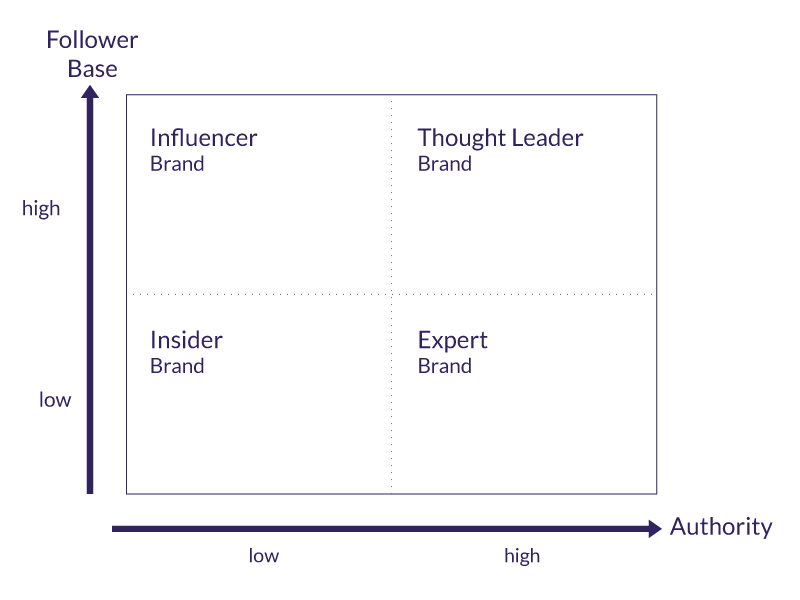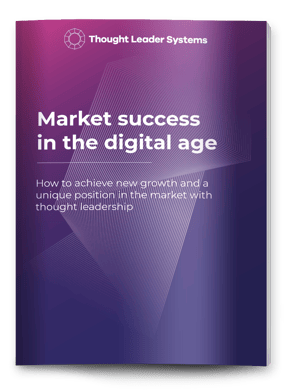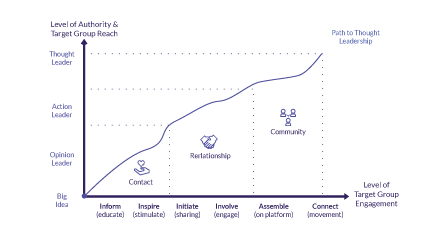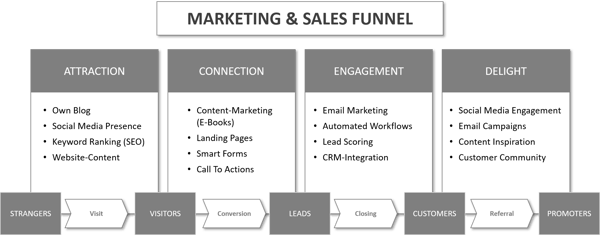The selection of the appropriate strategy to build thought leadership begins with an analysis of the status quo - potentials, capabilities, resources as well as vision, mission, and goals. Because in order to help new ideas, products, and business models to break through, strategic planning and procedures are required.
Use gap and scenario planning to develop alternative approaches and strategy paths in order to achieve your thought leadership goals and the entrepreneurial or financial goals behind them with the highest possible effectiveness and efficiency within the planned timeframe.


Great ideas and the pioneers of new techniques, products and concepts have always conquered our minds and hearts intuitively.
The difference in the digital era: Today, more and more people and companies are discovering the structural principles and professional applications of Thought Leadership for themselves. Every company, brand and institution (including NGOs) can become a thought leader.
The web and social media also give newcomers a reach and interaction opportunity that was unthinkable ten years ago.
But a great idea and the will to thought leadership alone are not enough.
Today's successful Thought Leaders know that this requires a well-functioning system. You have to anchor ideas and products in people's minds, involve people in the implementation of your own big idea and ultimately lead campaigns or build a customer community. Ideally, Thought Leadership is already part of the business model. However, it is always the result of well-coordinated measures.

Economic effects of Thought Leadership
Thought Leadership is universally applicable - across all industry boundaries and business models. This is what makes this management principle so interesting not only for companies.
Success stories that make targeted use of Thought Leadership, can be found everywhere in our society:
The different examples make it clear how individual a Thought Leadership Strategy can be in individual cases.
As a rule, it makes sense to systematically reflect on past successes as market pioneers, analyze opportunities that have been exploited and identify potential that has not yet been exploited in order to develop them with a targeted strategy.
In our cooperation with many companies, a fundamental, five-stage strategy process has proven its worth.
It all begins with setting the right goals, key performance indicators (KPIs) and the intended return on investment. The positioning to be achieved, the timeframe and the target groups (customers, public, employees) should already be defined.
Many factors such as the type of business model, the average acquisition costs of a new customer, their Customer Lifetime Value (CLV), the available budget and the sustainability of the desired competitive advantage determine the appropriate Thought Leadership Strategy.
The path to achieving the Thought Leadership goals results in the right strategy. The three basic types Campaigner, Innovator and Game Changer are widespread role models.
In many industries there are still many more conceivable and worthwhile positions and strategies. Above all, the chosen strategy must match your own strengths and resources.
Develop Thought Leadership that works equally for all target groups and markets.
In this phase, the necessary content is created on the basis of the defined goals and strategy in order to stage and experience the Thought Leadership positioning.
All concept elements should be consistently focused on value creation for the client and should also embody the claim of the thought leader to make this planet and people's lives better. This contribution to the benefit and well-being of all is not management esotericism, but proof of the credibility of the provider as a mastermind of his market. Examples such as ADAC or VW show how hard a company can otherwise be hit.
Give your Thought Leadership a face (Brand Face). Identify people in the company and on the market who should stand for your big idea and your brand. This includes internal brand faces such as top management and employees and external brand faces such as bloggers, experts, political or social personalities. These brand faces make the messages of your Thought Leadership positioning tangible.
Develop your Thought Leadership campaign and content strategy
Expand your Thought Leadership Management
This phase is the longest and often most important phase of a Thought Leadership Strategy. It shows whether thought Leadership is really deeply anchored in the vision and mission, brand and Leadership of the company.
Communication is a success factor whose impact is often underestimated. With excellent messaging and storytelling, Thought Leadership is firmly anchored with customers. This task is assigned to all visible Thought Leader protagonists of a brand (brand faces).
The CEO of a company is always an important brand face of his brand. Steve Jobs set a good example here at Apple and cultivated the brand myth personally - to the point of unmistakable messaging with the slogan "One more Thing", with which he introduced the highlight of every Apple presentation.
Other important brand faces are full-time brand faces such as Corporate Blogger or the Chief Customer Officer. They have a decisive influence on the perception and image of the company and should be involved and supported by all parties involved in the company as central drivers of Thought Leader positioning.
Build a Thought Leadership Excellence Team
Thought Leadership Marketing starts with the vision and idea of the business model. Design your business model in such a way that you inspire, involve and even actively involve people. Create contact and resonance with people through information and inspiration with valuable content and credible (brand faces).
Buyer Persona Management
Campaign Management
Content Marketing & Storytelling
Influencer Marketing
Brand Community Management
Public Relations & Corporate Communications
Inbound marketing is the art of being found by the customer instead of constantly bombarding him with advertising. If you do inbound marketing, you should master several tools:

In our work with customers, for example, we create our own catalog of key performance indicators, which we use to monitor the positive effects of the Thought Leadership strategy.
The CEO is the most important communicator in the company. The communication of your executive floor (C-Suite) has a huge impact on the external appearance of your company.
You can only realize Thought Leadership if you involve the top executives of your company in the storytelling and activities of your Thought Leadership marketing. Only then will you be able to build the necessary reach and credibility - both internally and externally.
About TLS
Contact
Newsletter